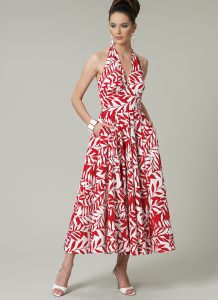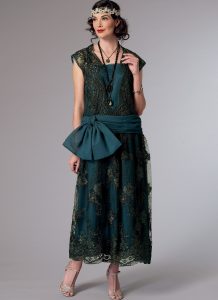Marilyn Monroe move over – Great British Sewing Bee week 9
The start of Movie Week saw the remaining four contestants making a Marilyn Monroe inspired halter dress with pleated skirt and then a 1920’s flapper dress as their final challenge. Both options meant sewing with tricky fabrics. I’ve a few tips and tricks to make these special fabrics easier to handle.

Make your own Marilyn Monroe style halter dress (Vogue Pattern 8727)
- Prevent curved and bias cut seams from stretching whist you are handling them by stay stitching first – stitch with a regular stitch length just inside the seam allowance.
- Bagging out means that you line the garment, sewing the main garment and lining right sides together around edges, leaving a turning gap. You then turn through so all the seams are neatly encased.
- Even on bagged out garments, if possible do also ‘understitch’ as far as you can. To do this, press the seam allowance towards the lining and then stitch on the lining, close to the seam, catching the seam allowance as you go. This stitching will show on the lining, but it definitely helps keep a crisper edge to the garment and prevents the lining from rolling out.
- To make even pleats, mark the fold line with one colour and the placement line with another. Then you can quickly fold the fabric at fold line and place the fold on the placement line – creating even pleats in the every time.
- Pressing pleated fabric – take care when pressing seams so you don’t press the beautifully pleated fabric flat! Just press the seams, using the tip of the iron only.
- Allow a garment to hang for at least 24 hours before hemming, particularly if it has bias cut side seams (ie is A-line or more). The side seams may well droop a bit as they are more stretchy. Then trim the hem line evenly before hemming.
- The best hem finish for a fine pleated fabric is definitely a rolled hem stitched on an overlocker.
- A quick way to hand sew hooks and eyes is to pull off about 2m of thread, fold it in half. Then slip the fold through the eye of the needle and bring it down so you have four strands of thread hanging from the eye. Knot the ends together. You now just have got go through the eyes of the hook a couple of times to secure them quickly.

Sew specialist fabrics for your flapper dress with confidence (Butterick 6399)
- Sewing Beaded or Sequin fabric can be tricky. On most beaded garments you will need to crush the beads in the seam area before sewing the seam. They have to be crushed (with a hammer) not cut away as cutting the threads could unravel more beads than you want!
- Some sequins can be stitched through – if they are soft and bendy. More traditional hard sequins also need to be cut away from the seam line otherwise you can break needles, as well as have a nasty scratchy seam against the skin. Again cut them away rather than cut the thread to avoid loosing too many!
- If you have a sequin fabric that is an all-over design with sequins attached in every direction, hand sew seams – it’s quicker than cutting away masses of sequins. Also make sure you line the garment so the sequins in the seam don’t scratch you when you wear the garment.
- When working with slippery silky or fine lightweight fabrics, consider using a walking foot which will help feed layers evenly. Also / or put a bit of tissue under the fabric at the start of a seam to help prevent the fabric being pulled into the feed dogs at the beginner (and end).
- If you do need to press sequinned or beaded fabric, use a Velvet Needle Mat/Board – it is a soft board or cloth coveted with a plush/pile fabric. You place the garment fabric face down so the surface decoration sinks into the pile of the board. If you don’t have one, use a piece of fleece or towel.
Enjoy sewing with specialist fabrics!
